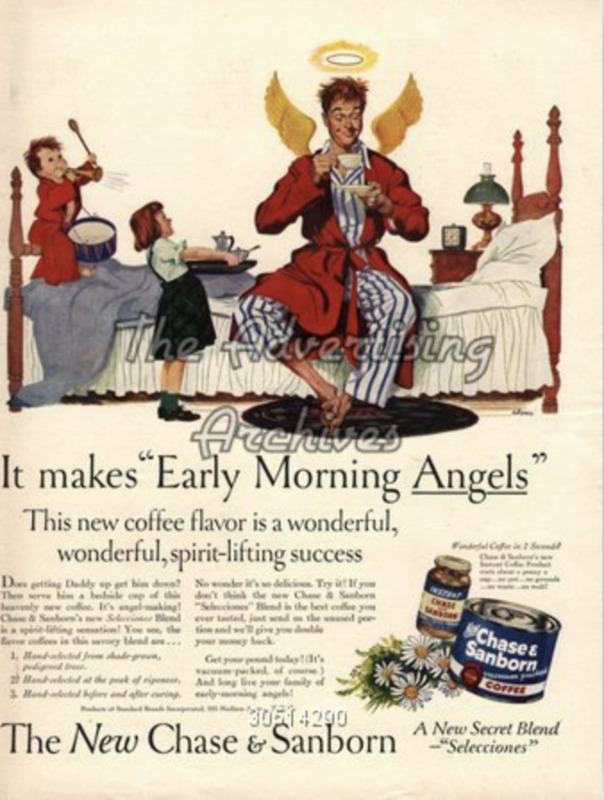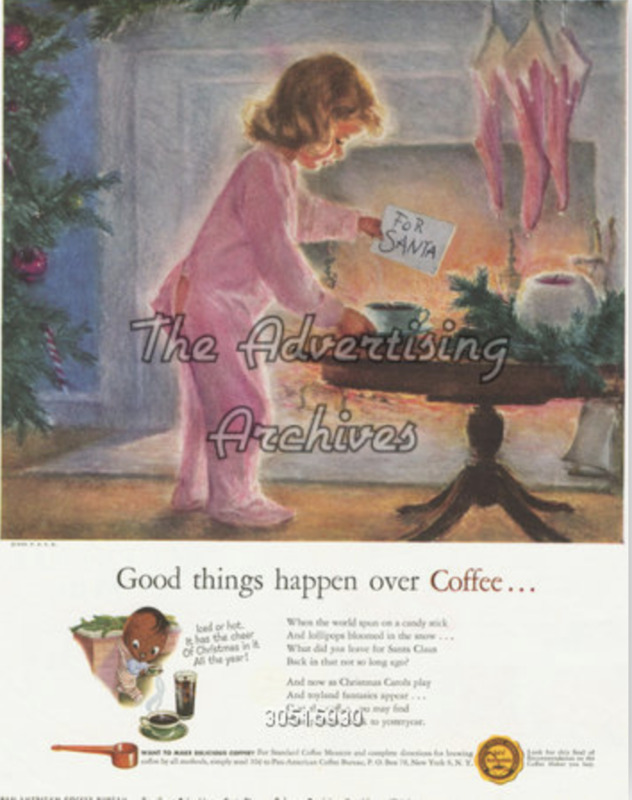Children as Active Participants in Gendered Coffee Advertisements
A few coffee advertisements at this time took the domestication of the process of making and serving the beverage one step further and extended it to young girls. This is evidence of advertisers, who at the time were mainly white men, instilling ideas of domesticity in girls from a young age. It also suggested to parents that mothers should teach their daughters how to make and serve coffee to others starting when they are young.
This 1940s magazine advertisement by Maxwell House Coffee depicts a young girl, who looks tiny compared to the bed, serving a tray of coffee to her father, who sits in pajamas in his bed. A young boy, presumably the girl’s brother, plays with musical toys in the background. The text of the advertisement suggests that “getting Daddy up” can be difficult, but this particular brand of coffee makes it easier. There is no woman present in the image, so presumably, she sent her daughter to go bring her father his morning coffee, passing on that domestic duty to her. Because the boy is playing in the background, the mother clearly chose to not give her son any chores, indicating that serving coffee is a female task and reinforcing gender roles in the kitchen, the parents pass along expectations of who does what on to another generation. This is in line with Parkin's analysis that that 20th century food advertisers "clearly delineated different roles for boys and girls and the men and women they would grow up to be," (Parkin 203). Another thing to note is that the mother would have woken up before her husband in order to get her kids ready for the day and make coffee, while the father slept in.
The wings and halo, as seen on the father, are generally associated with innocence. It is interesting that the creator of this advertisement would have placed them on the father and not the daughter. Perhaps the illustrator was trying to show that when a child serves someone coffee, they transfer part of this innocence with it. This innocence could not stem from anyone besides a child, so she can therefore do something that a grown woman could not. Additionally, the small size of the girl next to her father relates to Parkin’s fourth strategy of food advertisers, showing women’s subservience to men.
In this 1950s advertisement for the Pan American Coffee Bureau, a young girl leaves a cup of coffee under the fireplace with a note saying “For Santa.” The girl is participating in the act of serving coffee, even if it is not to a person who will immediately drink it. Therefore, she carries on the duty of serving coffee. Although many children leave out food and beverages on Christmas Eve, the fact that it is coffee is significant, because it hints to viewers of the advertisement that it is really a gift that will be consumed by parents later, perhaps after a long day celebrating. The large words in the advertisements, “Good things happen over Coffee…” suggest that because the girl gave Santa coffee, she will benefit, and therefore the behavior should be reinforced.
In the bottom left corner of the advertisement, there is another young girl. She has darker skin and appears to be singing or happily rhyming a verse about how the coffee spreads Christmas cheer. She is also wearing an apron, indicating that she has done some level preparation of the coffee and perhaps is some kind of servant. This young girl, who is also present in other advertisements for the Pan American Coffee Bureau, shows that the company also had a racialized approach to advertising, as she is likely meant to be from South America. The young girl clearly participated in doing the work of making coffee, even though in all of these cases, it was for a white family, reflecting racist attitudes toward servitude. As Silke Hackenesch argues, advertising coffee “via images of blackness...appears to be ‘natural’; it seems plausible, and as such produces a high degree of ‘truth,’ of social normativity’” (Hackensch 98-99). Therefore, the young girl is likely meant to not be thought twice about and to function merely as a symbol for servitude in both a gender and racially specific way.
This advertisement, also from the Pan American Coffee Bureau in the 1950s, features what looks like a grandmother teaching her young granddaughter how to make coffee. The advertisement is titled, “What Every Young Girl Should Know,” which directly correlates the making of coffee to a requirement for femininity in the household. The text emphasizes the popularity of coffee in the United States and says that “So what every young girl must know, if she hopes some day to be a good wife, is how to make good coffee — morning, noon and night.” Therefore, the advertisement directly states that in order to be a “good wife,” which every woman should strive to be, girls should learn how to make coffee from a young age. The grandmother also seems proud to be passing on this tradition to her granddaughter, as if she is protecting an important family custom.
This advertisement provides interesting insight into how advertisers may have been thinking about their audience. Assuming this advertisement was placed into women’s magazines or other materials that may have been read by primarily women, the advertisement forces women to think about how they are meant to be good wives and reflect on if they are doing a good job. This reflects back to Parkin’s first theme in women’s food advertising, passing on the message that women should show their love for their families through food (Parkin 8). The love between the grandmother and the granddaughter, for instance, looks like something to be emulated, and that emulation can be envied through teaching how to make coffee, according to the advertisement.



